

This week The English Apple Man reports on visits to Packing and Storage sites in Bolzano in the Italian Tyrol and the last of the Pink Lady picking on a 10 hectare farm near Bolzano.
The two sites we visited belong to separate Cooperatives - Kaiser Alexander and ZwolfMalgreien DodicVille, both are very close to the Town of Bolzano. The two sites have 72 and 60 Isolcell DCA stores respectively. The capacity of the stores vary from 240 - 370 tonnes with an average of 300 tonnes each.
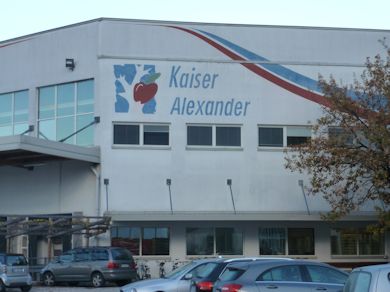
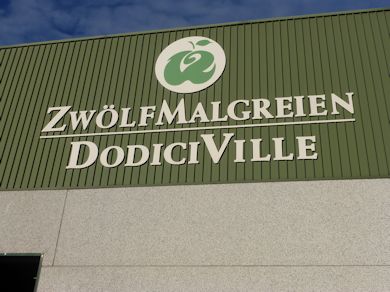
 The stores we were visiting are at the cutting edge of storage systems; our guide for the visits, Tito Spaldi - Area Manager for Isocel one of the leading suppliers of Dynamic Controlled Atmosphere (DCA).
The stores we were visiting are at the cutting edge of storage systems; our guide for the visits, Tito Spaldi - Area Manager for Isocel one of the leading suppliers of Dynamic Controlled Atmosphere (DCA).
A little history of Controlled Atmosphere Storage in the UK
"Following the systematic studies by Kidd et al. (1927) on the effects of elevated carbon dioxide on apple physiology, particularly respiratory behaviour, there has been sustained international research effort to maximise the effect of controlled atmosphere (CA) for different cultivars of apple.
The wider use of controlling the storage atmosphere by use of C/A goes back more than half a century; Back in the 1970's UK growers were urged to invest in more C/A (Controlled Atmosphere) storage as we; 'as an industry' were missing valuable marketing potential in the latter stages of the UK season (September to March/April/May).
At first the new investment was slow to 'take off' and even at the start the new Millennium much more investment was needed as new higher cropping varieties began to make their mark on the UK crop volume.. With the need for more C/A storage UK growers increased their storage considerably during the first decade of the Millennium.
In recent years as UK growers reclaimed market share by replacing imported Gala and Breaburn with English grown fruit, the potential to take our home grown apples further into early summer; competing with imports from Europe and new season Southern Hemisphere apples, the need for more sophisticated storage became clear.
A Global Perspective
On a Global basis, growers in the USA, Europe and the Southern Hemisphere, many depending on exports for survival, started to look for a new approach. Much of the early work was carried out by research institutes in North America.
ISOSTORE
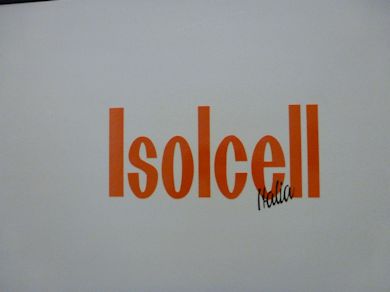 More than 350.000 tons of apples are stored worldwide using ISOSTORE® technology.
More than 350.000 tons of apples are stored worldwide using ISOSTORE® technology.
This new technology was patented in Canada and further developed by the researcher Dr. Angelo Zanella of the Agricultural Research Institue Laimburg. It has been applied successfully for the medium-long term storage of apples and is distributed exclusively by ISOLCELL Italia S.p.A. the leading company in this sector.
This technology uses fluorescence detection sensors to dynamically control the atmosphere and allows storage of fruit at its lowest respiration rate.
These sensors called F.I.R.M. (Fluorescence Interactive Response Monitor) measure the amount of light emitted by the fruit's peel in the form of fluorescence. This enables us to exactly pin point the A.C.P. (Anaerobic Compensation Point) an essential parameter in determining the minimum level of O2 to be maintained in the room during storage. The use of these sensors ensures the quick and precise determination of the A.C.P. both online and in real time, making the use of ISOSTORE® technology both very easy and very safe.
DCA History - An overview by The English Apple Man
In 2012,The English Apple Man reported on DCA in the Journal for 30th November; to visit click on Dynamic Controlled Atmosphere
In 2013, The English Apple Man reported on Dynamic Control of Respiration (DCR) in the Journal for 12th April; to visit click on Dynamic Control of Respiration
Below left: Fluorescence detection units (on display at Interpoma) are placed within the store detecting the change in fruit condition allowing accurate monitoring of the fruit condition and adjustment to the level of Oxygen in the store; Oxygen can be kept at levels of 0.2 - 0.3% delivering superior storage life in comparison to traditional C/A stores where Oxygen levels are kept at (circa) 1-1.2% depending on variety.
Below right: Part of the DCA systems at the Kaiser Alexander Cooperative Storage site
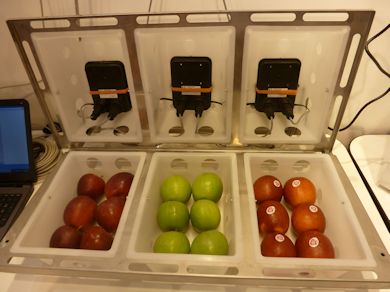
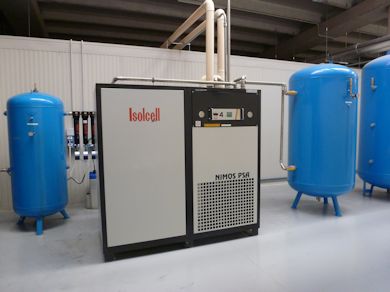
Unlike traditional direct expansion refrigeration systems where a refrigerant gas occupies the entire system in all zones, the Glycol secondary system has its refrigerant contained within a full-featured packaged stainless steel chiller.
The most suitable cooling systems to obtain optimal fruit storage in Controlled Atmosphere conditions are the indirect refrigeration type.
The Isolcell system, which is supplied for plants of medium to large size, compared to the traditional direct expansion system, has the advantage that it can achieve a lower "Delta T" air-to-refrigerant; consequently higher relative humidity is maintained, meaning a lower fruit weight loss.
Below left: An Isolcell refrigeration system unit - Below right; Inside an apple store, these plastic apple bins, each of which holds 360kg of apples are stacked 13 bins high!
Plastic bins are expensive; circa 80 Euros each, but have many advantages over the wooden bins used in the UK; hygiene, longevity, and strength are the obvious benefits and with the ability to stack nearly twice as high as we do in the UK with wooden bins, the cost per cubic metre of storage space is inevitably much cheaper.
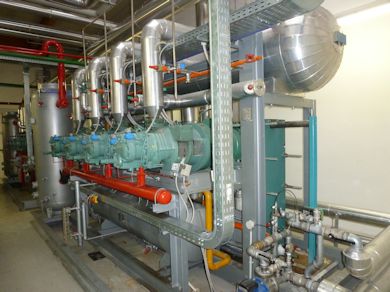
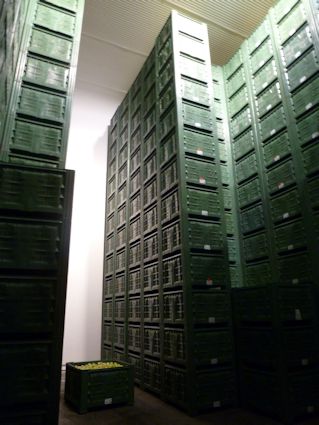
Energy use efficiency is continuously under scrutiny; the adoption of solar panels on the roof provides 60% of the energy required to run the storage and packing operation; Isolcell have made ongoing advances in the energy efficiency of their refrigeration and DCA equipment. Tito Spaldi told us the newest equipment uses only 60% of the energy required by installations made just two years ago.
Below; solar panels on the roof, are positioned at every point where the sun's rays can be harnessed.
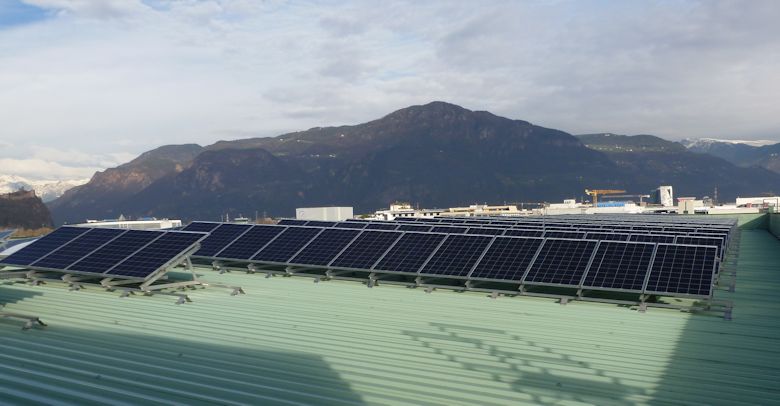
While touring the storage complex, two signs caught my eye; one displaying the 'green energy story' denoting energy saving via solar use and CO2 reduction. The second a DANGER sign reminding all operatives in the storage areas of the dangers of very low Oxygen levels. These dangers are very real; exposure to air starved of Oxygen will cause immediate unconsciousness.
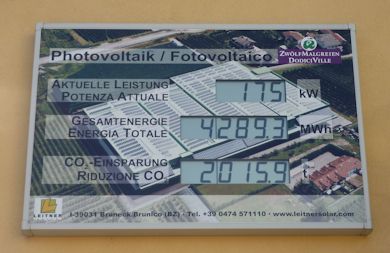

In the pack-house all aspects of the packing process are designed to be 'ultra efficient' and the picture below shows apples (Golden Delicious) passing through the water flumes from the computer controlled grading system, to the packing points and onto the automatic tray - pallet stacking point, before collection in the dispatch area.
This packhouse can deal with one bin (360kg) every two minutes; e.g. 10.8 tonnes every hour.
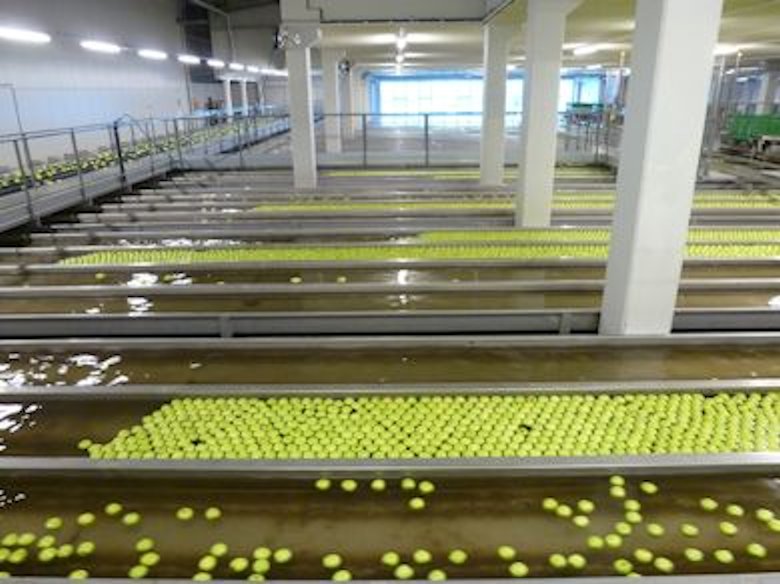
Below left; Golden Delicious and Gala on packing lines - Below right; the Dispatch area
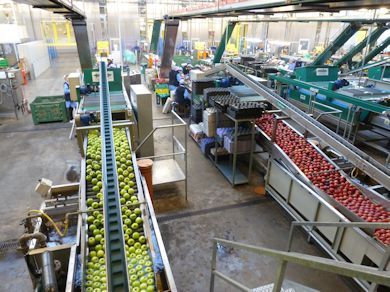
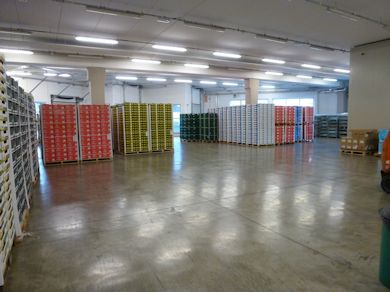
From the storage and packing complex's we moved onto a 10 hectare farm (large for the Tyrol) where the last of the Pink Lady crop was in the process of being harvested.
It seemed surreal for the Gala trees to have completely lost their leaves, while the Rosyglow had been picked but still held their leaves and the Pink Lady was still being picked.
Below left; Gala trees with all leaves on the ground - Below right; Rosyglow trees recently picked
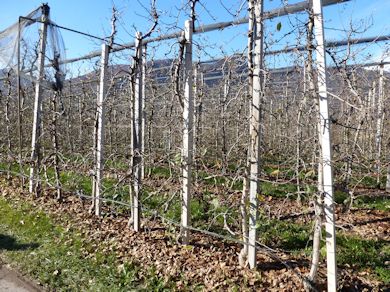
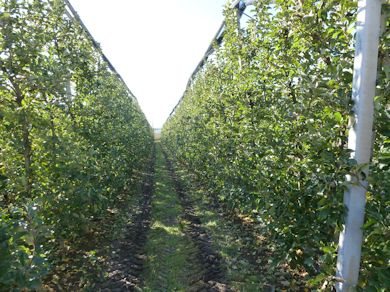
Below left & right - Pink Lady picking using a Hermes picking platform
Use of the Hermes picking platform maximises performance and quality.
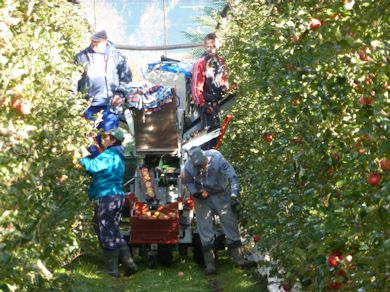
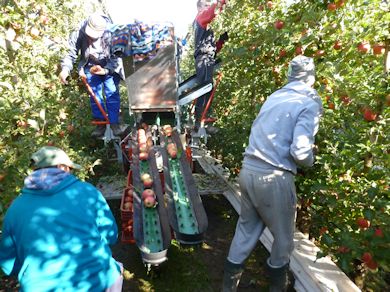
Summarising the visits on Friday 21st November; the widespread use of DCA storage technology at both storage sites is now normal practice, equally the adoption of energy saving technology and state of the art packing systems is standard. Yields of Pink Lady reach 100 tonnes per hectare annually.
One of the sites we visited handles 54,000 tonnes of apples annually = to 25% of all the apples grown in England!
That is all for now.........more apple related stories next week.......
Take care
The English Apple Man